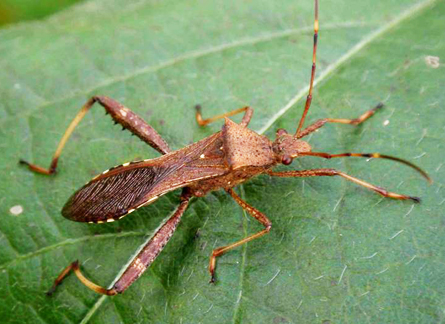Insects and microbes have teamed up against a pesticide commonly sprayed on crops. In lab tests, swallowing a bellyful of certain bacteria protected bugs from the toxic chemical.

This detoxifying diet is the first example of a symbiotic relationship that provides insecticide resistance, scientists report online April 23 in the Proceedings of the National Academy of Sciences.
“Mechanisms of insecticide resistance have been thought to be encoded by the insect genomes themselves,” says Yoshitomo Kikuchi, a microbiologist at the National Institute of Advanced Industrial Science and Technology in Hokkaido, Japan. “Our findings overturn the common sense.”
Kikuchi and his colleagues treated pots of soil with fenitrothion, a cheap insecticide used worldwide. Burkholderia bacteria, which can disarm the pesticide and break it down for its carbon, flourished in the dirt.
The insecticide-munching microbes also thrived inside young bean bugs, or Riptortus pedestris, exposed to seedlings grown in the pots or fed the bacteria by the researchers. A single insect can support an estimated 100 million Burkholderia cells in its gut. In return for providing a comfortable living space, infected bean bugs acquired a new tolerance to the pesticide in the lab. Most of the insects survived doses of fenitrothion that killed 80 percent or more of their undefended comrades within five days.
Some scientists worry that this route to resistance could spread quickly in agricultural fields. Insecticide resistance typically evolves slowly, as genetic changes arise in successive insect generations. Snatching up soil bacteria, which reproduce and thus evolve much faster, seems an easy shortcut. Bugs flying from place to place could also spread their microbial allies around.
“This could explain why insecticides are more effective some times than other times,” says Nancy Moran, an evolutionary biologist at Yale University.
Searching for resistant insects outside the lab, Kikuchi’s team visited agricultural sites scattered across Japan. At a sugarcane field on Minami Daito-Island, 8 percent of the adult stinkbugs captured by the researchers harbored Burkholderia that could break down the insecticide.
That’s not many bugs, says Bruce Tabashnik, an entomologist at the University of Arizona in Tucson. He doubts that the bacteria provide much protection in actual fields, where insects are exposed to larger doses of fenitrothion than they received in the new experiment.
“The increased ability to survive exposure to insecticide conferred by the symbionts is relatively small,” says Tabashnik. “It might not be enough to be relevant in most places.”






